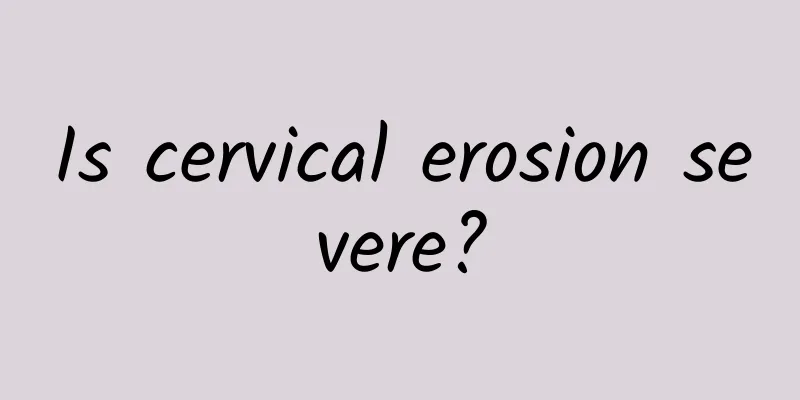Is cervical erosion severe?

|
Severe cervical erosion needs to be taken seriously, but not all cases mean serious diseases. Cervical erosion is a common physiological phenomenon of cervical surface cells. Severe erosion may be related to inflammation, infection or cervical lesions. Treatment methods include drug therapy, physical therapy and surgical treatment. The specific choice should be determined according to the cause and condition. 1. Causes of severe cervical erosion There are many causes of severe cervical erosion, which may be related to the following factors. Genetic factors may make the cervical tissue more fragile and prone to erosion. Environmental factors such as long-term exposure to chemicals or bad living habits such as smoking may also increase the risk. Physiological factors such as fluctuations in hormone levels, especially high estrogen levels, may lead to hyperplasia of cervical epithelial cells. Trauma such as multiple births or cervical surgery may damage cervical tissue. Pathological factors include chronic cervicitis, human papillomavirus (HPV) infection, etc., which may develop into cervical precancerous lesions in severe cases. 2. Treatment of severe cervical erosion The treatment method should be selected according to the specific cause and condition. Drug therapy is suitable for mild to moderate erosion. Commonly used drugs include anti-inflammatory drugs such as metronidazole, antiviral drugs such as acyclovir, and hormone drugs such as estrogen ointment. Physical therapy is suitable for moderate to severe erosion. Common methods include laser therapy, cryotherapy and electrocautery therapy, which promote the regeneration of healthy tissue by destroying abnormal cells. Surgical treatment is suitable for severe erosion or suspected precancerous lesions. Common surgeries include cervical conization, LEEP knife surgery and hysterectomy. Surgery can completely remove the diseased tissue. 3. Lifestyle adjustment and prevention Lifestyle conditioning plays an important role in relieving the symptoms of cervical erosion and preventing recurrence. In terms of diet, it is recommended to consume more foods rich in vitamins C and E, such as citrus fruits and nuts, to enhance immunity. Avoid spicy and irritating foods to reduce inflammatory responses. In terms of exercise, moderate aerobic exercise such as brisk walking and yoga can help improve blood circulation and enhance physical fitness. Maintaining good personal hygiene habits, avoiding the use of irritating lotions, and regular gynecological examinations, especially HPV screening and cervical cytology examinations, can help detect and treat lesions early. Although severe cervical erosion requires attention, most patients can effectively control the condition through scientific treatment and a healthy lifestyle. Regular examinations, early intervention and personalized treatment are the key to managing cervical erosion. If you feel uncomfortable or have suspected symptoms, you should seek medical attention in time to avoid delaying treatment. |
<<: Cervical adhesion after abortion
>>: How to check which bacteria causes chronic cervicitis
Recommend
Tao Jingying apologizes after her endorsement product was removed from shelves: Willing to be punished
When faced with the controversy surrounding the p...
What are the obvious manifestations of early symptoms of uterine fibroids
Uterine fibroids are the most common gynecologica...
Don't let fat settle accounts after the New Year. These three teas can remove oil and relieve greasiness.
Are you worried about gaining weight during the C...
What are the early symptoms of ovarian cysts?
Ovarian cysts can occur at any age in women's...
What is exercise intensity and exercise dosage? Rehabilitation Physician: 7 Essential Conditions for a Complete Exercise Prescription
As modern society becomes more and more convenien...
What should women with cervical erosion pay attention to in their diet? Patients with cervical erosion should take three steps to take care of themselves
Cervical erosion is a common cervical disease in ...
Obesity is not only a chronic disease, 8 of the top 10 causes of death are related to obesity! Obesity also increases risk of COVID-19 infection
Obesity has become one of the top global health i...
What are the clinical manifestations of cervicitis?
I don't know if you know the clinical manifes...
Why does aerobic exercise need to last more than 20 minutes to be effective?
Anyone who is used to doing aerobic exercise know...
Experts explain the symptoms of uterine fibroids
After suffering from uterine fibroids, patients w...
What is vulvar leukoplakia? 4 symptoms of vulvar leukoplakia
What are the common vulvar leukoplakia diseases? ...
7-Day Pumpkin Light Meal to Detox and Help Lose Weight
In October, there is an important festival called...
Can women with chronic cervicitis not be treated? How can patients with chronic cervicitis regulate themselves?
Chronic cervicitis is an inflammatory reaction of...
Patients should pay attention to the precautions after ectopic pregnancy surgery
Nowadays, many women are prone to ectopic pregnan...
How to check female adnexitis
Female adnexitis can be diagnosed through physica...









